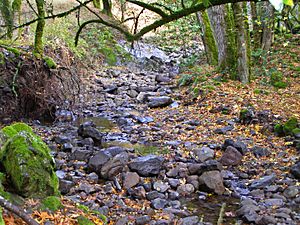Copeland Creek (California) facts for kids
Quick facts for kids Copeland Creek |
|
|---|---|

Copeland Creek with basalt armor in channel, Fairfield Osborn Preserve
|
|
|
Location of the mouth of Copeland Creek in California
|
|
| Country | United States |
| State | California |
| Region | Sonoma County |
| Cities | Penngrove, California, Rohnert Park, California |
| Physical characteristics | |
| Main source | Sonoma Mountain 38°19′52″N 122°34′38″W / 38.33111°N 122.57722°W |
| River mouth | Laguna de Santa Rosa west of Rohnert Park, California 92 ft (28 m) 38°20′37″N 122°43′25″W / 38.34361°N 122.72361°W |
Copeland Creek is a stream in Sonoma County, California. It is about 9.0-mile-long (14.5 km). This creek starts on Sonoma Mountain and flows all year round.
Contents
About Copeland Creek
The creek begins high up on Sonoma Mountain. This area is just above the Fairfield Osborn Preserve. As it flows downhill, the middle parts of the creek pass through lands used for grazing animals and vineyards.
When Copeland Creek reaches the flat valley floor, it flows right through the campus of Sonoma State University. From there, it continues its journey until it empties into the Laguna de Santa Rosa. The water from Copeland Creek eventually joins the Russian River. The Russian River then flows out to the Pacific Ocean.
History of the Creek
For a very long time, different groups of Native American people lived near Copeland Creek. These included the Coast Miwok, Wappo, and Pomo peoples. They were hunter-gatherers, meaning they found their food by hunting animals and gathering plants. They were the main users of the land around the creek for many years.
In the early 1800s, Europeans arrived in the area. Soon after, too many animals were grazing, even high up on the mountain. This caused problems for the creek. Luckily, the upper parts of the creek were later fixed. This happened after William Matson Roth bought the land that is now the Fairfield Osborn Preserve.
Restoring the Lower Creek
The lower parts of the creek were also in bad shape until the 1990s. A project began to restore the area between Roberts Road and Petaluma Hill Road. Historically, these lower areas had many native plants like alder and willow trees.
However, cattle grazing and walking on the plants damaged the creek. This made it harder for fish to lay their eggs. The plants that used to shade the water were gone, making the water warmer. Also, the water became muddy, covering the gravel where fish lay eggs. Some parts of the creek were still being overgrazed as of 2006.
Overgrazing also caused the creek banks to wear away, which is called erosion. This allowed new plants that were not native to the area to grow, replacing the natural ones. This change in plants also hurt animals like birds, amphibians, and small invertebrates that live in the creek area.
Creek Wildlife and Plants

The upper parts of Copeland Creek are home to many different plants and animals. The main types of plants are California oak woodlands. You can also find Douglas fir trees and riparian woodlands, which are forests that grow along rivers and streams.
Trees and Plants
In the oak woodlands, you'll see trees like the coast live oak, Oregon oak, California black oak, canyon live oak, and California bay laurel. Underneath these trees, there are smaller plants like toyon, coffeeberry, poison oak, and snowberry. There's even a rare plant called American ginseng.
Animals in the Creek
The upper parts of Copeland Creek are very important for wildlife. The red-legged frog, which is an endangered animal, lives here. The creek's upper areas have many California bay laurel trees, which provide a great habitat for many amphibians, newts, and other creatures.
The Pacific giant salamander, one of the biggest salamanders known, hunts for food in the upper creek. Other amphibians you might see include the Pacific treefrog, the rough-skinned newt, and the California slender salamander.
Managing Copeland Creek
The Sonoma County Water Agency helps manage Copeland Creek. In 2006, they removed plants like cattails and arroyo willow from some lower parts of the creek. This was done to help the water flow better and prevent flooding. However, changing a stream can sometimes have unexpected effects on the environment.
Future Plans for the Creek
The county has plans for Copeland Creek. They want to create a Copeland Creek Trail along the creek. This trail would connect Rohnert Park, near Sonoma State University, to Crane Creek Regional Park. There are also plans for a Copeland Creek Regional Park of about 500 acres (2.0 km2). This park would be located near the Fairfield Osborn Preserve. In the city of Rohnert Park, much of the creek has been made into a straight channel.
Restoration Efforts
The Sonoma County Water Agency and the California Department of Fish and Game are working together. They have a plan to help fish lay eggs in the Russian River and its smaller streams, including Copeland Creek. This project helps three threatened types of fish: Coho salmon, Chinook salmon, and steelhead. These fish are called anadromous because they live in the ocean but swim up rivers to lay their eggs.
A project called the Copeland Creek Restoration Project focused on about 6,000 ft (1,800 m) of the creek. This part of the creek had been overgrazed by cattle for over 100 years. The project started in 1999 and finished in 2003. Its goals were to make the creek banks stronger, reduce mud in the water, keep cattle out of the creek with fences, and improve the habitat for steelhead and other native fish and wildlife.
Because of this project, the creek now has less mud. Its channel also has a more natural wavy shape, instead of the almost straight line it had before.


